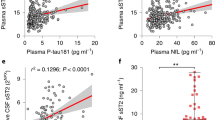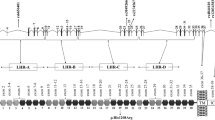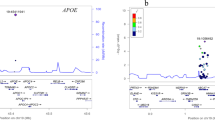Abstract
β-site amyloid precursor protein cleaving enzyme (BACE1) is the rate-limiting enzyme for production of beta-amyloid peptides (Aβ), which are proposed to drive the pathological changes found in Alzheimer’s disease (AD). Reticulon 3 (RTN3) is a negative modulator of BACE1 (β-secretase) proteolytic activity, while peptidylprolyl isomerase (cyclophilin)-like 2 (PPIL2) positively regulates BACE1 expression. The present study investigated whether there was any association between genetic variation in RTN3 and PPIL2, and either risk for AD, or levels of platelet β-secretase activity, in a large Northern Irish case-control sample. Four hundred and sixty-nine patients with a diagnosis of probable AD (NINCDS-ADRDA criteria) and 347 control individuals (MMSE > 28/30) were genotyped. SNPs in both genes were selected by downloading genotype data from the International HapMap Project (Phase II) and tags selected using multimarker approach in Haploview, where r 2 > 0.8 and LOD > 3.0. Non-synonymous SNPs of interest were also included. Genotyping was performed by Sequenom iPLEX and TaqMan technologies. Alleles, genotypes and multi-marker haplotypes were tested for association with AD, and platelet β-secretase activities were measured for a subset of individuals (n = 231). Eight SNPs in RTN3 and 7 in PPIL2 were genotyped. We found no significant associations between allele, genotype or haplotype frequencies and risk of AD. Further, there was no effect of genotype on platelet membrane β-secretase activity. We conclude that common or potentially functional genetic variation in these BACE1 interacting proteins does not affect platelet membrane β-secretase activity or contribute to risk of AD in this population.


Similar content being viewed by others
References
Barrett, J. C., Fry, B., Maller, J., & Daly, M. J. (2005). Haploview: Analysis and visualization of LD and haplotype maps. Bioinformatics, 21, 263–265.
Citron, M. (2004). Beta-secretase inhibition for the treatment of Alzheimer’s disease—promise and challenge. Trends in Pharmacological Sciences, 25, 92–97.
Colciaghi, F., Marcello, E., Borroni, B., Zimmermann, M., Caltagirone, C., Cattabeni, F., et al. (2004). Platelet APP, ADAM 10 and BACE alterations in the early stages of Alzheimer disease. Neurology, 62, 498–501.
Espeseth, A. S., Huang, Q., Gates, A., Xu, M., Yu, Y., Simon, A. J., et al. (2006). A genome wide analysis of ubiquitin ligases in APP processing identifies a novel regulator of BACE1 mRNA levels. Molecular and Cellular Neurosciences, 33, 227–235.
Folstein, M. F., Folstein, S. E., & McHugh, P. R. (1975). Mini-mental state. A practical method for grading the cognitive state of patients for the clinician. Journal of Psychiatric Research, 12, 189–198.
Fukumoto, H., Cheung, B. S., Hyman, B. T., & Irizarry, M. C. (2002). Beta-secretase protein and activity are increased in the neocortex in Alzheimer disease. Archives of Neurology, 59, 1381–1389.
Gabriel, S. B., Schaffner, S. F., Nguyen, H., Moore, J. M., Roy, J., Blumenstiel, B., et al. (2002). The structure of haplotype blocks in the human genome. Science, 296, 2225–2229.
Haass, C. (2004). Take five—BACE and the gamma-secretase quartet conduct Alzheimer’s amyloid beta-peptide generation. EMBO Journal, 23, 483–488.
Hardy, J. (2006). Has the amyloid cascade hypothesis for Alzheimer’s disease been proved? Current Alzheimer Research, 3, 71–73.
Hardy, J., & Allsop, D. (1991). Amyloid deposition as the central event in the aetiology of Alzheimer’s disease. Trends in Pharmacological Sciences, 12, 383–388.
He, W., Hu, X., Shi, Q., Zhou, X., Lu, Y., Fisher, C., et al. (2006). Mapping of interaction domains mediating binding between BACE1 and RTN/Nogo proteins. Journal of Molecular Biology, 363, 625–634.
He, W., Lu, Y., Qahwash, I., Hu, X. Y., Chang, A., & Yan, R. (2004). Reticulon family members modulate BACE1 activity and amyloid-beta peptide generation. Nature Medicine, 10, 959–965.
Holsinger, R. M., McLean, C. A., Beyreuther, K., Masters, C. L., & Evin, G. (2002). Increased expression of the amyloid precursor beta-secretase in Alzheimer’s disease. Annals of Neurology, 51, 783–786.
Holsinger, R. M., McLean, C. A., Collins, S. J., Masters, C. L., & Evin, G. (2004). Increased beta-Secretase activity in cerebrospinal fluid of Alzheimer’s disease subjects. Annals of Neurology, 55, 898–899.
Hu, X., Shi, Q., Zhou, X., He, W., Yi, H., Yin, X., et al. (2007). Transgenic mice overexpressing reticulon 3 develop neuritic abnormalities. EMBO Journal, 26, 2755–2767.
Hubbard, T. J., Aken, B. L., Beal, K., Ballester, B., Caccamo, M., Chen, Y., et al. (2007). Ensembl 2007. Nucleic Acids Research, 35, D610–D617.
Johnston, J. A., Liu, W. W., Coulson, D. T., Todd, S., Murphy, S., Brennan, S., et al. (2008). Platelet beta-secretase activity is increased in Alzheimer’s disease. Neurobiology of Aging, 29, 661–668.
Li, R., Lindholm, K., Yang, L. B., Yue, X., Citron, M., Yan, R., et al. (2004). Amyloid beta peptide load is correlated with increased beta-secretase activity in sporadic Alzheimer’s disease patients. Proceedings of the National Academy of Sciences of the United States of America, 101, 3632–3637.
Liu, W. W., Todd, S., Craig, D., Passmore, A. P., Coulson, D. T., Murphy, S., et al. (2007). Elevated platelet beta-secretase activity in mild cognitive impairment. Dementia and Geriatric Cognitive Disorders, 24, 464–468.
McKhann, G., Drachman, D., Folstein, M., Katzman, R., Price, D., & Stadlan, E. M. (1984). Clinical diagnosis of Alzheimer’s disease: report of the NINCDS-ADRDA Work Group under the auspices of Department of Health and Human Services Task Force on Alzheimer’s Disease. Neurology, 34, 939–944.
Miller, S. A., Dykes, D. D., & Polesky, H. F. (1988). A simple salting out procedure for extracting DNA from human nucleated cells. Nucleic Acids Research, 16, 1215.
Moreira, E. F., Jaworski, C. J., & Rodriguez, I. R. (1999). Cloning of a novel member of the reticulon gene family (RTN3): Gene structure and chromosomal localization to 11q13. Genomics, 58, 73–81.
Murayama, K. S., Kametani, F., Saito, S., Kume, H., Akiyama, H., & Araki, W. (2006). Reticulons RTN3 and RTN4-B/C interact with BACE1 and inhibit its ability to produce amyloid beta-protein. European Journal of Neuroscience, 24, 1237–1244.
Stockley, J. H., Ravid, R., & O’Neill, C. (2006). Altered beta-secretase enzyme kinetics and levels of both BACE1 and BACE2 in the Alzheimer’s disease brain. FEBS Letters, 580, 6550–6560.
Tang, K., Hynan, L. S., Baskin, F., & Rosenberg, R. N. (2006). Platelet amyloid precursor protein processing: A bio-marker for Alzheimer’s disease. Journal of the Neurological Sciences, 240, 53–58.
Todd, S., McKnight, A. J., Liu, W. W., Carson, R., Heggarty, S., McGuinness, B., et al. (2008). BACE1 polymorphisms do not influence platelet membrane beta-secretase activity or genetic susceptibility for Alzheimer’s disease in the northern Irish population. Neuromolecular Medicine, 10, 368–376.
Vassar, R. (2004). BACE1: The beta-secretase enzyme in Alzheimer’s disease. Journal of Molecular Neuroscience, 23, 105–114.
Wakana, Y., Koyama, S., Nakajima, K., Hatsuzawa, K., Nagahama, M., Tani, K., et al. (2005). Reticulon 3 is involved in membrane trafficking between the endoplasmic reticulum and Golgi. Biochemical and Biophysical Research Communications, 334, 1198–1205.
Wang, B. B., Hayenga, K. J., Payan, D. G., & Fisher, J. M. (1996). Identification of a nuclear-specific cyclophilin which interacts with the proteinase inhibitor eglin c. Biochemical Journal, 314, 313–319.
Yan, R., Shi, Q., Hu, X., & Zhou, X. (2006). Reticulon proteins: Emerging players in neurodegenerative diseases. Cellular and Molecular Life Sciences, 63, 877–889.
Zhao, J., Fu, Y., Yasvoina, M., Shao, P., Hitt, B., O’Connor, T., et al. (2007). Beta-site amyloid precursor protein cleaving enzyme 1 levels become elevated in neurons around amyloid plaques: Implications for Alzheimer’s disease pathogenesis. Journal of Neuroscience, 27, 3639–3649.
Acknowledgements
This work has been supported by funding from the Stewart Endowment and the Research & Development Office, Health and Personal Social Services, N. Ireland; and has benefited from participation in the Northern Ireland Centre in the Alzheimer’s Research Trust’s research network. We thank the American Federation for Aging Research for the award of Beeson Fellowships to B.McG and S.T.
Author information
Authors and Affiliations
Corresponding author
Rights and permissions
About this article
Cite this article
Carson, R., McKnight, A.J., Todd, S. et al. Variation in RTN3 and PPIL2 Genes Does not Influence Platelet Membrane β-Secretase Activity or Susceptibility to Alzheimer’s Disease in the Northern Irish Population. Neuromol Med 11, 337–344 (2009). https://doi.org/10.1007/s12017-009-8080-3
Received:
Accepted:
Published:
Issue Date:
DOI: https://doi.org/10.1007/s12017-009-8080-3




